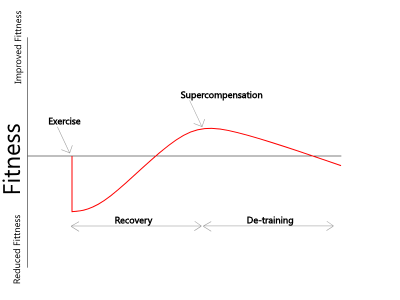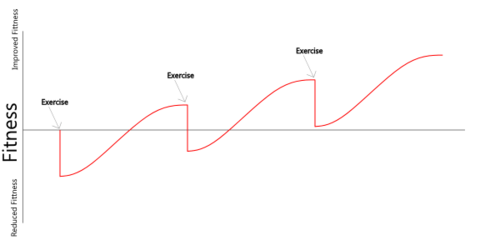How Often To Run

There is a natural human belief that if some is good, more is better. This idea is all too often false, and can be destructive with training. There's an old adage that "running does not make you a better runner, it's the rest that follows running that makes you a better runner". Getting the right balance of running and rest is a critical part of your training.
Contents
1 Supercompensation and Monotony
It's well accepted that exercise improves fitness, and there are many different Endurance Adaptations that occur. The primary mechanism for these adaptations is that exercise causes damage and this damage is repaired to be stronger than before the exercise. This is seen in the fatigue that occurs after exercise, and the need for rest. The term for this mechanism is Supercompensation, and is a key principle for creating training programs. One way of evaluating a training program is Training Monotony which looks at the variation in daily training stress. Higher levels of Training Monotony are associated with reduced benefits and a greater risk of Overtraining Syndrome. This need to optimize the ratio and timing of exercise and rest has been known for many years. Weight training regimes have exercised particular muscle groups on alternating days and most endurance training programs have used harder days and easier days.
2 Easy Days and Junk Miles
A common approach to optimizing Supercompensation and Training Monotony is to have 3 or fewer hard training days combined with a number of easier days. For this approach to work, the easy days need to be sufficiently easy. Carl Foster said "for best results make your hard days very, very hard and your easy days very, very easy". Running on the easy days is often referred to as "junk miles" as the only result of these miles is impairing recovery. If the benefits of training go down as the effort on easy days increases, why train at all on the easy days? So far I have found no evidence to indicate there is any training benefit from running on the easy days, therefore I recommend only 3-4 times a week for most people.
3 Running Patterns
There are various patterns of running that I would generally recommend.
- 3 days/week. This is the pattern used by FIRST, which is the only marathon training plan I've found that has performed scientific studies to evaluate its effectiveness. Running 3 days/week requires that every days is hard, and typically involves a Long Run and two speedwork days. The ratio of running to rest gives 2 days of rest, and these typically follow the long run.
- 4 days/week. Having two back to back running days allows for one training day that has incomplete recovery. Typically these two back to back days are used for long runs, so that the second day simulates a longer distance Long Run. It is possible to arrange 4 days/week as two sets of back to back days, but this is not common.
- 3.5 days/week. Running every other day is a great pattern, but logistically it is hard to organize.
4 Exceptions
If your running is not hard enough to require 48 hours recovery, you may be better off running more often.
- If you are just Starting to run then you may not running hard enough to require the days off. However, I believe that 3 days/week is probably optimal.
- If you are running for fun and not pushing your body hard, then running 5-6 days a week may work for you.
- If you have DOMS, such as after a long race, more frequent Recovery Runs may help.
- During a Taper it may be appropriate to increase frequency while dramatically reducing intensity and duration. Currently there is insufficient evidence to reach a recommendation.
5 Mental Health Runs
One of the complaints concerning running 3 or 4 days/week is that every run is hard and therefore there is no running for fun. Sometimes a short, easy run can provide mental benefits, and these can be worthwhile overall, even if these "mental health runs" degrade the overall training program effectiveness.
6 Overload Training
Running hard or long everyday will build up cumulative fatigue as the body does not have sufficient time to recover. If this is kept up too longer, then some type of failure will occur; either injury or some form of Overtraining. However, it is possible to run for a number of days consecutively, building up deeper cumulative fatigue, and then taking a longer rest period. This is one of the principles of the Three Phase Taper.
7 Doubles
Running 3 or 4 days/week does not mean running at most once per day. It can be effective or necessary to run more than once per day while running fewer days per week. Running more than once in a day can provide some of the training stress of a single longer run.
8 Cross Training
Running is different to many other forms of exercise because a large portion of the training stress is eccentric, and eccentric exercise tends to require a longer recovery period. Performing some non-eccentric cross training such as cycling may be possible between running days without unduly compromising recovery. The research performed with the FIRST training program suggests that this cross training may be useful.
9 Training Plans
The FIRST plan is based around running three days a week, and is the only plan I am aware of that has undergone scientific evaluation about its effectiveness. Hal Higdon's Advanced II Marathon[1] plan has 6 days of running, but two days are trivial. Jeff Galloway[2] uses four days/week. The Runner's World beginners plan [3]is four days/week. (The RW intermediary & advanced are 5 days.) Jack Daniels defines just two work outs a week, and leaves it up to you how you fit in the other miles.
10 Active Recovery
What about 'active recovery'? This is the idea that low intensity exercise improves recovery from high intensity exercise. In the context of easy exercise on the day after hard exercise, I've only found one scientific study [4][5] and that indicated that active recovery does nothing to help. Note that "Active Recovery" can have other meanings:
- 'Active Recovery' can refer to doing low intensity exercise between the work periods of Interval Training, which is effective.
- Doing gentle exercise immediately after intense exercise as a Cooldown may have some benefits. There is anecdotal evidence that walking for 20-30 minutes after a Long Run reduces muscle soreness.
11 How Often I Run
I did my first ultra in 2005 using a fairly conventional pattern of running. I would run six days a week, with two days as the long run back-to-back days. Around July 2008 I started to focus on making my hard days harder and my easy days easier. Gradually this became more extreme, and I won my first race in April 2009. In August 2009 I started running 4 days/week and I found my performance continue to improve. I tried running more frequently for six months and found it ineffective and counterproductive.
- I have found the most effective pattern for me is to run four days a week. I aim to run 16-27 miles, which gives me lots of long running, with enough rest to support that mileage.
- Two of my runs are back to back. The idea is that I have not fully recovered from Friday when I do the Saturday run, so I am doing a Long Run on tired legs. I do this because I cannot afford the time that it would take to run the distances that would otherwise be required. I consider Friday/Saturday to be a single training unit, though not as effective as the mileage would be if I could do it on a single day.
- If I were training for the marathon distance or shorter, I would train three days per week. For these shorter races it would not be as difficult to get an adequately long Long Run.
- I will occasionally do extra "mental health runs", but I keep these short, typically only 10-15% of the length of my usual runs.
- I will often run more frequently during a Taper or after a race, especially if I have DOMS.
12 The Psychology of Running Frequency
Running 3-4 days a week is not just tough physically; it's tough mentally as well. Obviously it is tough to run hard enough to need the 48 hours recovery. However, the feeling that days off mean not doing enough, or that a rest day will cause fitness to dissipate is corrosive.
13 See Also
14 References
- ↑ http://www.halhigdon.com/marathon/advanced2/advancedII.htm
- ↑ http://www.jeffgalloway.com/training/marathon.html
- ↑ http://www.runnersworld.com/article/0,7120,s6-238-244--6946-2-3X5X7-4,00.html
- ↑ http://www.ncbi.nlm.nih.gov/pubmed/18202563 http://www.ncbi.nlm.nih.gov/pubmed/18202563 Neuromuscular fatigue and recovery in elite female soccer: effects of active recovery.
- ↑ http://evidencebasedfitness.blogspot.com/2008/02/rest-vs-active-recovery.html Rest v Active Recovery
